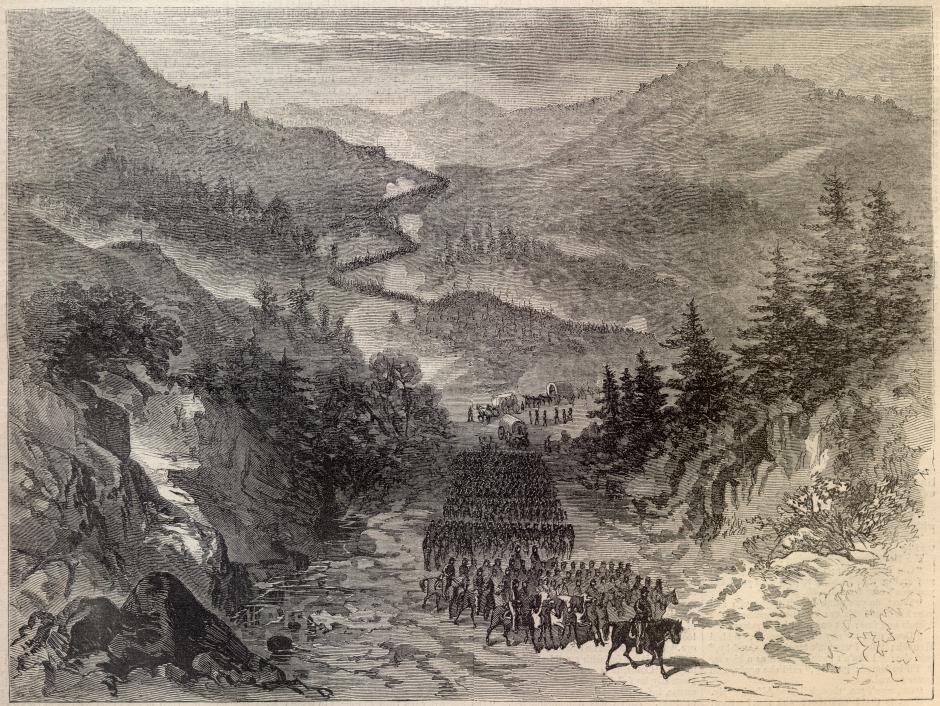
I’ve always been fascinated by mountain men and how they knew the backcountry inside and out. Men like Jim Bridger and Jim Baker. The next couple of posts are going to be about navigating the mountains and various techniques for knowing your general whereabouts and what to do when you get lost.
I found this initial entry in “Mountain Scouting, A Hand-Book for Officers and Soldiers on the Frontiers” by Edward S. Farrow, U.S. Army, 1881.
Edward Farrow sounds like he was a good guy to have around in a tricky situation. Enjoy!
Mountain Travel.
A good mountaineer is usually guided by the same instinct that carries the bee to its hive. By day he uses the sun and the prominent landmarks; while in his night marches, the stars may serve to give the direction. Polaris and Ursa Major, or the Southern Cross, give the north and south bearing, while the Zodiacal stars indicate the east and west points. It is seldom that the ordinary traveler, even when provided with compass, sextant and chronometer and after careful practice and cultivation, becomes skilled in mountain craft.
In a mountainous country, where the routes of possible travel are few, a guide with a good local knowledge is very desirable; for the compass is by no means sure when in the vicinity of granitic rocks (rich in hornblende and other iron bearing ores). Unless possessing a local knowledge of the country, guides are only useful when water and camping places are scarce and must be hunted and when messengers may be needed.
Before going into the mountains, if possible, a map should be secured, correctly showing the large streams, their general directions and important tributaries,—and the line of march and probable location of the camp should be noted on the map daily. It will not do to trust too much the ‘bump of locality,’ but every ‘sign’ indicating direction should be carefully considered. In some latitudes the moss grows much thicker and stronger on the north side of the firs and pines, which fact may enable the traveler to direct his course through the forest in the absence of all other guides. Again, the ripples in the snow on the mountain tops often run in fixed directions, in consequence of constant winds, and these may serve as a guide.

In order to successfully travel the mountains, it is necessary to understand their complete ‘make up’ and to know how to skillfully follow the divides. When the divide A E B separates the waters of two streams not uniting with each other, as C and D in the drawing, it is known as a principal divide, and always affords the best route of travel.
The sides of canyons and ravines are frequently so precipitous that it is neither advisable nor possible to cross them; and although it is sometimes easy traveling along the bottoms (the level land enclosed between the sides,) when not too narrow and rocky, the best route will, considering all things, be found along the divides. Such a route is frequently long and crooked, but it is a good one.
Suppose it be required to pass from the stream C to the stream D, parallel to it, but separated from it by very high and broken mountains.
To accomplish this most expeditiously, follow up the stream to C, where we will suppose a tributary of the stream puts in. Now if there be a good route, apparently, over the divide above this tributary, turn to the right and follow it, until the principal divide is reached at E. The route, if practicable, may be taken along the bottom, should water be desirable, as far as necessary and then the divide C E may be taken. Having reached the principal divide, pass over it and descend by any suitable and practical divide as E D, leading from the principal divide, to the other stream. It will be found that all the divides lead to the principal divide, and hence there will be no doubt as to finding the principal divide; but it will often require good judgment in selecting the most practicable divide leading to it. It will be still more difficult to select the practicable divide in descending, as all appear more or less practicable from the summit. The innumerable cul de sacs, met with in descending, can only be avoided by exercising great caution. In every case the divide selected should separate tributary ravines of two important tributaries of the stream. It is seen in the drawing how these ravines frequently overlap each other and render the route very sinuous.
It is recommended to follow game trails, when discovered, in passing from one stream to another. They usually follow the most direct and practicable route over a fair divide. When arriving at the steep edge of a ridge, and where difficulty in finding a good trail is anticipated, it is a safe rule to descend first, on foot, and seek a trail for the command or train as you climb back again. It is much easier to make this selection while ascending than while descending; for when at the bottom of a hill, its bluffs and precipices face you, so that they may be readily avoided, but when at the top of the hill these parts are overlooked and not seen, until closely approached.
The investigation of ravines is the exact reverse of that of the divides; but localities are much more readily lost when the ravines proceed thence in various directions. On crossing a divide and coming upon a system of ravines leading to a different principal ravine, the traveler should make very sure of his course and frequently take the bearings of the most prominent landmarks.